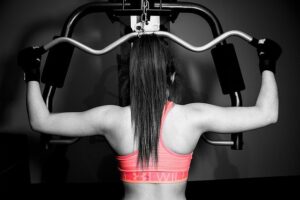6 Standing Desk Exercises to Keep your Mind and Body at the Ready

If you have an adjustable standing desk, it’s clear that you understand the health benefits to be on your feet rather than spending 40+ hours a day at a desk. Failing to utilize your bones and muscles for extended amounts of time can have real repercussions for your mental and physical health.
https://www.youtube.com/watch?v=N8tE6zSPJ7w
Why Choose a Standing Desk?
Most people who work an office job understand the norm to be sitting all day while working. Many work at a computer now, so the idea that you would stand and work at the computer is incredibly difficult in a traditional desk. Sitting is what we see in TV and movies of office workers, but things are slowly changing. Change is slow though. Most bosses expect that you stay seated while working in order to achieve uniformity and maximum productivity. There are very good reasons to challenge that norm, however, first of all starting with health concerns.
Health Concerns
A number of things can become problematic if you do not stand while working. Blood flow is crucial to a healthy heart and limber limbs. If blood flow is constricted from a seated position, it’s very likely that conditions can develop into problems down the road, such as heart disease, heart attack, diabetes, and stroke. These are extreme issues, but they are not helped by sitting for multiple hours a day. Not to mention, many who work full time don’t make the time for exercise, which is incredibly important. Later, we’ll dive into the ways you can exercise at your standing desk, but there’s another incentive for challenging the norm of sitting while working.
Health Benefits
Contrast to the concerns associated with sitting, standing at a desk and doing exercises throughout the day can really help your health. The easiest way to start benefiting from standing at a desk is to find a way to get a standing desk. Standing is a natural stance for us to be in, whether we’re at work or not. It may be a rough transition at first, but it’s worth it. Soreness and stiffness can occur when you first start using a standing desk, but utilizing exercises helps ease you into the process.
The first thing you’ll notice to improve is your posture, Sitting allows us to keep a burden off of our bodies, but it damages our spine and neck, causing pain, and even in extreme cases, disfigurement. Stiffness occurs due to a lack of blood flow, and can end up hurting your posture within weeks of going untreated. Your muscles and body as a whole desires to be used, and the more you stand, the happier your body will be. If you can imagine, the pain that can build over years of bad posture adds up quickly. Hunching over or leaning too far back does damage faster than you’d imagine, but standing helps to keep your posture straight and natural.
You might not be a huge athlete, but it’s important to keep a healthy flexibility as well. You don’t need to be a bodybuilder or runner to care about your flexibility, and you’ve experienced issues with flexibility even if you haven’t noticed. Think of a commute to a vacation or even work. Whether you’re taken a plane, car, or train, you know the feeling of being stir crazy and having pain from sitting for too long. It’s no different when you’re working at a seated desk. It’s important to avoid that pain because it occurs as a warning sign that you are losing range of motion. It might go away after a few moments standing, but over time, it takes its toll on your limbs. You don’t need to actively stretch to keep your flexibility up. Just standing does a great job of keeping you limber, and it’s crucial to stay on your feet when you can to help.
You also burn calories just by standing, and that’s before any of these exercises we’ll discuss. Your body weight is basically like a natural weight that you hold up when you stand, and that contributes positive benefits to your health as well. You are much more active while standing than when seated. It’s also a great way to start to build healthier habits. The more you’re on your feet, the more comfortable you’ll be to do more exercises. The exercises we’ll discuss are not difficult, and really go a long way. So let’s discuss exercises we can do at a standing desk to improve our health.
6 Stand up Desk Exercises to Keep your Mind and Body at the Ready
Glutes
Glute workouts are wonderful for an office setting because you don’t have to draw attention or do much movement to participate in them. Glutes are basically the muscles in your butt that help keep things lean, firm, and perky. These are great workouts to help with clothes fitting better and feeling more confident in your back side. The workout you can participate in at a standing desk for you glutes is called a Gluteal Squeeze. Very much like the name, you squeeze or contract your butt and hold for 2-3 seconds, and throughout the day, you can do this many times without drawing the attention of others. After a few weeks of doing so, you will see results.
It’s a low intensity workout that doesn’t cause attention and you can actually perform it over and over. There’s no to low recovery time, and you’ll be happy with the results.
Calves
You calf muscles are one that many notice when you wear shorts, or even tighter pants. Calves are an easy muscle to work on over time, and it’s another subtle workout you can do at work. While standing, you can perform what is called a Calf Raise. Start with your feet equally apart at shoulder length, and raise up slowly to your tip-toes and holding for 1-3 seconds. You should do these exercises in sets of 3 for about 10-15 reps. They may not feel difficult the first few times you do them, but by the final set you’ll feel the burn.
The great thing about Calf Raises is that they pay off quickly. A few weeks of doing these at your desk makes a huge difference, and will help to feature your calves in a much more dignified way. It’s something that anyone can do, and since you use your body weight to do them, you’ll feel more strength in your legs, and may experience improved walking, running, and jogging.
Squats
Squats are a much more strenuous workout, but they do a lot for only being one workout. Everything waist down is worked out during a squat, and you feel the burn predominantly in your quads. These are basically, again as it sounds, squatting down, but it’s complicated to do a proper squat. Let’s go through the steps. First, keep your feet shoulder length apart and your backs straight. Then, as if you were sitting on an invisible chair, lower your behind while maintaining a straight back until you’re making a 90 degree angle with your legs.
Squats are a workout you can do with a standing desk for some extra help if you need assistance for balance. The benefits of a squat are eliminated however if you lean on the desk, so be sure to use it for help only if needed, and not too often. Squats can be done in a number of sets and reps, but to start, consider 3 sets of 10 squats to be a good warm up. Add more to each set as you go, and think about what it means to overwork a muscle.
If you do 100 squats your first day, it would take days to recover, and you’d be forced to sit again and lose the benefits of a standing desk. Squats are one of the most popular workouts because they do so much for you, and at a standing desk, they’re even easier.
Legs
Utilize your desk for something called a Lateral Leg Raise. The desk is meant to serve as a support if needed, but again, doesn’t overutilize it. The muscles in a Lateral Leg Raise adduct to form stronger muscles on the inside and outside of the quad. This helps tone your leg and build strength to transfer to faster running, jogging, and walking. Lift each leg as high as you can while keeping your back straight and pointing your toes towards your desk. Hold each leg lift for 5-7 seconds, and do 3 sets of 10 reps. these can add up quickly, and you may struggle at first.
Because we’re not often lifting our legs to such a high level, your body can really feel the strain, but it’s important to remember that you need to be careful in order to not injure yourself. Make sure to go carefully for each exercise, but especially for your legs considering that you’re going to be on your feet at your new standing desk. These Lateral Leg Raise workouts help with multiple parts of your lower body, and if your lower body is in tact, it’s much easier to perform upper body exercises properly.
Triceps
Triceps are a bit hard to do with weights, but two great options are available at your standing desk and both help build strength and muscle. The first is called a Tricep Dip, which is something you’ll only want to do on a sturdy desk. Facing away from the desk, you’ll place your palms on the surface of the desk, and lower yourself with your arms at a 90 degree angle. 3 sets of 15 reps will get you a great arm workout, but if that doesn’t work there is an alternative that is equally helpful and beneficial.
A Desk Pushup is equally effective, which is literally a pushup using a standing desk rather than getting on the ground. They help take a little struggle out of the process of a push up by letting you hold yourself up by your legs as well as push yourself up. They’re equivalent to a pushup on your knees, which still works out your arm, just to a lesser degree.
Walking in Place
This one might seem silly at first, but walking in place actually mimics walking quite well. Walking is an easy way to stay in shape, and at a standing desk, it’s quite easy to continue to work and just walk in place. It’s one of the few exercises you can do while still working which makes it beneficial to your health as well as your productivity. There are a number of other workouts you can try at your desk, and a number of them are detailed in this article from Autonomous.
Conclusion
There are a number of reasons to be active, and at a standing desk in the office, you’re allowed the luxury of getting an extra chance to be doing things that are positive for your health. While seated, you not only stay inactive, but you also lack the ability to maintain proper blood flow and damage your limbs over time. It’s important to do these exercises and more, so start with these listed in the article, and move on to bigger and better exercises to keep active at work. Even if you have 10 minutes, it’s 10 minutes more than someone did sitting down. Staying active as much as you can is ideal because it keeps you immune to a handful of negative impacts of seated working.
For many workers, a job can take 40+ hours of your day away from you. If those hours are spent inactive, it’s possible that your body, and in the end you, could pay the price. It’s crucial you stay as active as possible if you’re able, and this is a guide to doing so at your standing desk. Mix work with active exercises and you may have productivity and your health down to a science.






![A Guide on How to Use Body Fat Scale [Latest Guide 2021] Body Fat Scale](https://www.meetrv.com/wp-content/uploads/2021/05/Body-Fat-Scale-300x157.jpg)